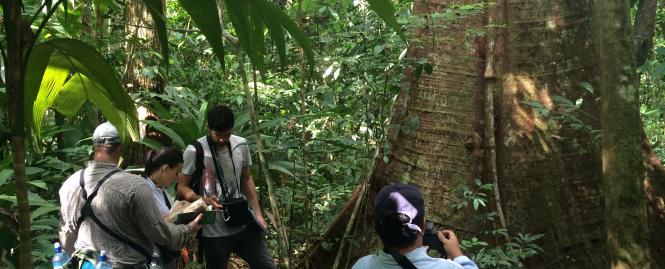Guide for the Identification of Trees in Critical Conservation Status in the Osa Peninsula

Guide for the Identification of Trees in Critical Conservation Status in the Osa Peninsula
"Costa Rica contains around 2000 species of trees, of which 119 are in critical conservation status according to the 2012 Status Report on Forest Genetic Resources (MINAE, SINAC, CONAGEBIO, FAO). In a more detailed analysis of this information undertaken by personnel in Golfo Dulce Forest Reserve (RFGD), botanists were able to determine that of the 119 species in a critical conservation status, 40 species are found within the Osa Peninsula.
Emblematic species of the Osa Peninsula such as Anthodiscus chocoensis (ajo negro), Buchenavia costaricensis (escobo), Caryodaphnosis burgeri (cirrí), Copaifera camibar (camibar), Couratari scottmorii (matasano), Myroxilon balsamun (Sándalo), and others remain on a conservation “red list” of trees in the Osa Peninsula.
Worried about the large gaps in existing information for the majority of these species, personnel from the RFGD decided to take action by developing a strategy for their recovery in the Osa.
The first step towards this is creating a user-friendly guide that allowed individuals to identify these threatened species. This effort is led by local botanist Reinaldo Aguilar, who collaborated with Caroline Salomon, a French student intern from Paris Agrotech who worked on this project from September 2014 to February 2015.
By the end of the internship, Caroline was able to develop the first version of a guide, called “Guide for the Identification of Trees in Critical Conservation Status in the Osa Peninsula” (see photo and the example of Buchenavia costaricensis), as well as develop protocols for fieldwork data collection, database management, and the creation of maps. With this work, 87 individuals of these threatened species were identified and mapped.
The ultimate goal of this project is to properly identify and locate 20 to 30 individuals of each species in the field, which would contribute to conducting research about the demography, phenology, pollination, dispersion, and other botanical characteristics that would help to fill important and existing information gaps. This research would then work toward the development of conservation strategies for each species.
It is in the search of these individual trees that the newly developed field guide will play a major role, since it can be used by a wide-range of users from residents of the Osa Peninsula to tourists. The guide’s broad usability is one of its primary objectives, which will develop toward a system of participatory monitoring, or citizen science, of these species.
In the short-term, ACOSA hopes to develop community greenhouses of these threatened tree species that function to raise the general awareness of their state of conservation. Additionally, the community greenhouses would facilitate income-generating activities associated with the threatened tree species, such as the sale of saplings. In the medium-term, ACOSA hopes to plant conservation stands of these threatened tree species. These efforts are aligned with the general conservation strategy of the RFGD."
For more information, please contact:
Juan José Jiménez, Forest Engineer
Manager of the Golfo Dulce Forest Reserve, ACOSA
Email: juan.jimenez@sinac.go.cr